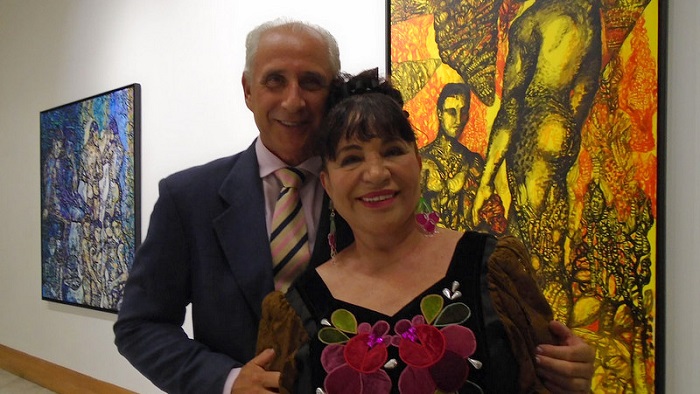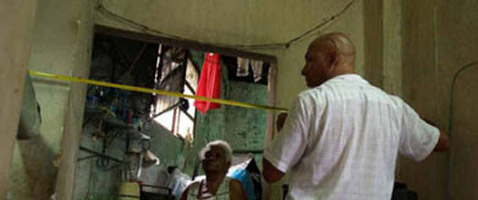(With regard to the recently granted 2010 National Plastic Arts Award)
Arte por Excelencias celebrates the granting of the National Plastic Arts Award to the artist René Francisco Rodriguez, Holguín, Cuba, 1960, by opening a dialogue about the significance of the work of this particular contemporary artist, creator of the project From a Pedagogic Pragmatics (DUPP in Spanish).
We are inviting Critics, Artists, Art Students or just people who know about his work to be part of this conversation that, as a start, we document with text Excerpts written by or about the Artist. With the reproduction of some pieces of the mentioned Exhibitions, we illustrate a chronological tour for different moments of his career grouped under the name of “Readings”, a code that also evokes René Francisco’s creative exercises. From Monday, December 13 you can publish your thoughts and comments on the Discussion page on Facebook.
If we aim, we will understand that the derisory objects, the unusual words, the broken mirror, fall on the asphalt when a call to arms is heard. They move, they move and they have their backside, their edges, a curative hiding. The season also has another face; multiplicity and pollution should not surprise us. Amid gasses and negative images, Poets can see, Painters can see, by alarming, by alternating the useless formality of the guardian.
The projects we have developed as part of From a Pedagogic Pragmatics constitute an artistic experience as those of us who have conceived it and made it have been involved in the analysis of Art’s Operational Problems, in this case, from a university point of view. In all these events, the Artist, the Students and the Public melt; I do not intend that the latter captures the meaning of its object, but he himself is the object and meaning.
[René Francisco Rodriguez, Excerpt of Occasional Manifest. From a Pedagogic Pragmatics, Higher Institute of Arts course 1989-1990, Havana, Feb. 1990.]
This time the work of the duet is made concrete in the exhibition act; when, by subverting the traditional concept of Authorship, the work of others is assumed to be their own and it is “signed”. This attitude not only shows the identification between the authors; the way in which they evidence their mutual acknowledgement of transferred talents is, at the same time, a symptom of maturity in their creative method. A work works as a major metaphor of the exhibition as it includes not only the author procedure which is common to all of them, but also the staging of dual work: two frames with the pictures of René Francisco y Ponjuán, alternating between intellectual activity and passivity position.
[Excerpt of “Alternate Current: René Francisco y Ponjuán”, by Researchers and Critics Ibis Hernandez Abascal and Margarita Sanchez Prieto, in catalogue from “Wifredo Lam” Center of Contemporary Arts. Havana January 1995.]
This artist, who spent ten years working in team with another painter, has shown his own personality and a social concern that he has been able to show on his trips to several parts of the World. It was just this year when he had the chance to travel to Canada to make an exhibition of the Installation Getting Ideas, an Interesting Updating of the Movie Art from the 1950s. In fact, René Francisco Rodriguez himself quotes Marcel Duchamp as part oh his initial ideas.
[Excerpt of “The Well of Fortune. René Francisco: Cuban Art in Movement”, by Critics Ana Trelles Sarazú, in Visto & Bueno, a. 3, no. 131, 7 Nov. 1997.]
Tubosutrais a name that originates from the parody combination of the words tube andKamasutra. Basically, on a first level of meaning, I am interested in using the representation of Kamasutra with small format sculptures made out of recycled toothpaste tubes; multiple- use- cream- tubes, medicine tubes. The immediate purpose is to deal with certain culture aspects of sexuality, as well as its expression in certain areas of urban visibility.

[René Francisco Rodriguez Hernandez, Excerpt of CatalogueII Salon of Cuban Contemporary Art, Havana, Nov. 1998.]
René Francisco, however, can not be apart the emphasis on the sociological aspects that have characterized all his previous production. His vision of things insists on a tendency to collective. Kamasutra is here only a pretext; this is the shallow part of the work, its formal structure, story shaped, mask of a sex Academy, sublimation of virtue and vice. In only one work the 64 love games that distinguish and isolate the Kamasutra can live together. But, according to the Artist, the hundreds of tubes that are shown on stage carry on their “skin” the trace of their users and, like mirrors somehow they return the daily matters, the individual lives that consumed their utility during the routine. Each one of these tubes is an Excerpt of intimacy that dissolves in a fragile and promiscuous tension with the rest.
[Excerpt of “Coito... ergo sum”, by Critics Eugenio Valdes Figueroa, Galería Habana, Havana, May. 1999.]
The intention of transforming Art teaching to make it transmit in the same frequency as the new Cuban Art, encouraged the ideas of René Francisco and oriented his searches to the deconstruction of the Traditional Pedagogical Discourse. To go beyond the limits of the academia practice, to bring pedagogic activity into life by turning the teaching act into a creative environment required by the immediate experience. To close the way to a verbal learning, full of tedious, limited and useless speeches were the directions in which From a Pedagogic Pragmatics chose its work tools to operate from and with the reality that was selected as the context of its practice.
[Excerpt of “Neo-vanguard, Inter-Cultural Issues and Humanism: toward a Pedagogic Pragmatics”, Published by Critics Lupe Álvarez, in From a Pedagogic Pragmatics, 1999.]
Any way, his pedagogic work stands out as one of the essential factors that have had an impact on the training of new promotions of students graduated at ISA (Higher Institute of Arts), while he has made possible a fluent artistic, inter-generational dialogue and, at the same time, he has encouraged the emergence of other important projects alternative to Arts teaching that enrich and diversify the approaches to creation inside the Academies.
[Excerpt of “Recognition to René Francisco”, text by Critic Suset Sanchez, in Cuban Art around the World, Havana, May 2000, p. 8.]
There are several factors that have influenced on the change of the thematic axis in the plastic production of René Francisco. It goes from the praising of the inclusion of Arts in Society, in the first place, going through inevitable self-lessons learned in the practice of his pedagogic project, up to the duet composed of home and the workshop. Undoubtedly, All use is Abuse, confirms his return; maybe not a definite one, to daily exercise.
[Excerpt of “Back to Daily Matters”, by Researcher and Critic Lourdes Benigni, published in The House of the Prize. Jan. 2002, p. 8.
On the latest productions by René Francisco all seems to attend this ludicrous space. I rethink of how his operation inherits Duchamp’s profit, the Dadaist conquest and pop sacralization; how his sensibility is based on historic legacy that seems to be showing at the minimum level due to very clean representations.
Excerpt of “To voucher”, by Critic Frency Fernandez, published in Noticias de Artecubano, Havana. a3, no. 3, Mar. 2002, p. 5.]
Crossed Histories is a smart x-ray of the reproduction and hypocrisyof human behaviour. It is a call to revision and collective self-conscience, an anthological exam of ideologization as a tool of domination, of civic control. At the same time, it is an answer to simulating poses and group consensus.
[Excerpt of “Crossed Histories" René Francisco Rodriguez”, by Critic Píter Ortega, Pan American ArtProjects, Miami, 2008]
 There are works that illustrate the condition of interpreter from the other’s perspective. In these pieces, my theoretical arguments are real, concrete and are expressed from the closeness of interpersonal relations. For example, there is “Agua Benita, that comes from the word Bendita (Holy). Benita was a person who worked at my house, that was with me when my daughter was born and taught me her experience, she advised me on what to do and what not to do, an extremely poor person with a very deteriorated house. I visited her on regular basis and she let me know her needs; between us there was a communication that generated this entire project. The Exhibition is made with people who always had a communication with me and it is based on the notion of desire, on the idea of the reparation of frustrations, the link between people who demand things and the people who make things.
There are works that illustrate the condition of interpreter from the other’s perspective. In these pieces, my theoretical arguments are real, concrete and are expressed from the closeness of interpersonal relations. For example, there is “Agua Benita, that comes from the word Bendita (Holy). Benita was a person who worked at my house, that was with me when my daughter was born and taught me her experience, she advised me on what to do and what not to do, an extremely poor person with a very deteriorated house. I visited her on regular basis and she let me know her needs; between us there was a communication that generated this entire project. The Exhibition is made with people who always had a communication with me and it is based on the notion of desire, on the idea of the reparation of frustrations, the link between people who demand things and the people who make things.
[René Francisco Rodriguez en “Multiple Stories” Excerpt, Interview published by the critic and editor of the Magazine Arte por Excelencias, en: www.arteporexcelencias.com, Mar. 27, 2009.]
If we wanted to summarize the artistic and pedagogical work of René Francisco, we should Stara by saying that he is the heir of the Volume I generation that were the teachers at the Higher Institute of Arts between 1982-87, while René Francisco was a student. During this same period René Francisco makes a creation duet with algunos de cuyos integrantes Eduardo Ponjuán. The duet keeps working for years during which they exhibited in national and international locations. The work they made is an important turning point in the beginning of René Francisco’s artistic career.
[Excerpt of “A Journey through the work of René Francisco”, Publisher by Researcher Farah Gomez in La Jiribilla, December 2010.]
Related Publications

Letter to Zaida del Río
October 08, 2018
Plastic Arts in Cuba, Life at a Glance
December 31, 2015
Mexico Bets on Contemporary Art
January 27, 2013














